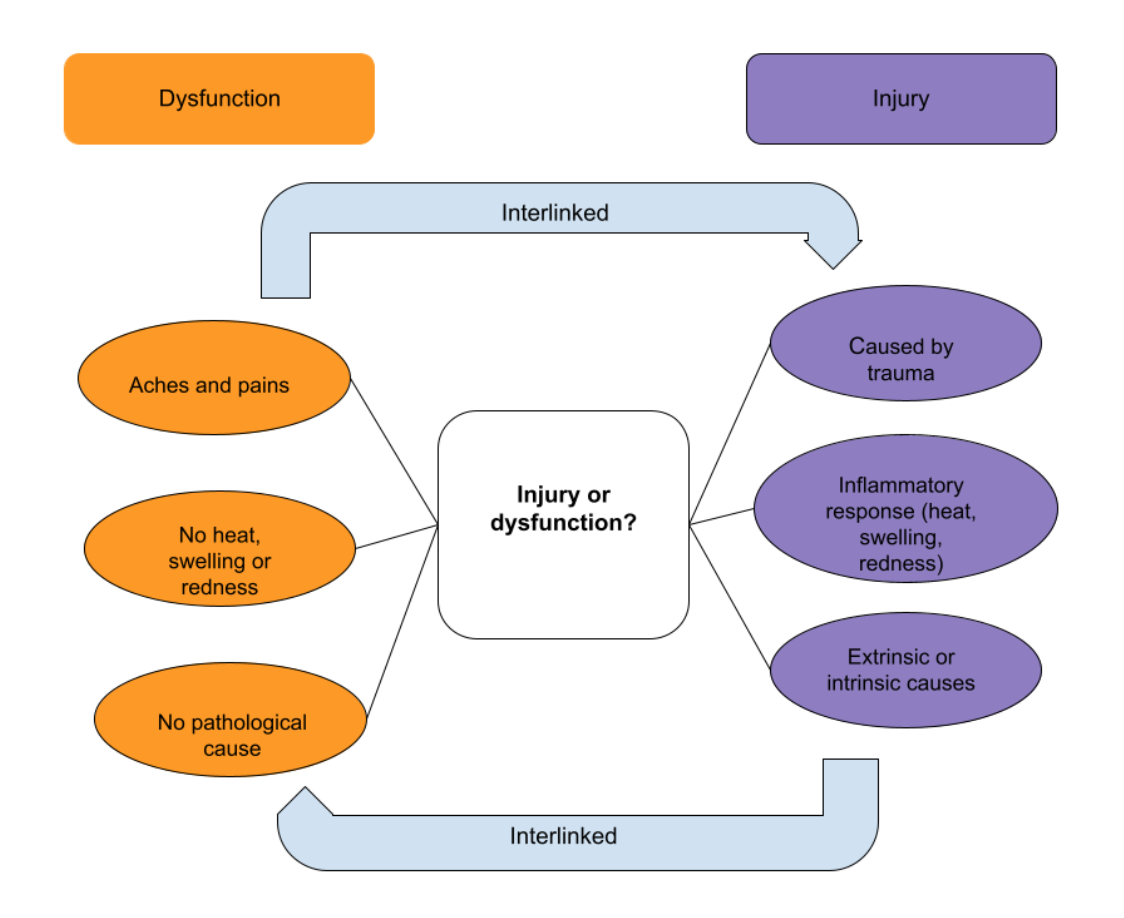

And why won't it go away?
If you struggle with little niggles, aches and pains every so often, you certainly aren’t alone. To an extent, these are part and parcel of leading an active life (and a good reason to have a sports massage every so often, to keep them at bay!). But sometimes it can feel like it’s just one thing after another, and that as soon as one little niggle clears up, the next one raises its annoying, nagging little head. What’s going on? And what can we do about it?
These little niggles are often not injuries as such, but the effects of dysfunctions. So what’s the difference? Here’s a handy little flow chart to help us differentiate between the two:

As you can see, injury and dysfunction are often (although not always) closely interlinked. For example, did you know that one risk factor for spraining your ankle is having already sprained your ankle in the past?[1] Which seems pretty unfair, but there it is - after it’s happened once, it’s more likely to happen again.
So what’s going on when an injury leads to dysfunction? Well, in some ways your body is being pretty clever. After an injury, your body works to protect itself - and you might not even know it. Take an example from my own past: many years ago, I broke a toe, strapped it up, hobbled around for a while trying to get on with life, then it healed up, and I thought no more of it. Except for many months later when I started experiencing fairly severe hip pain while training for a charity walk… of and a bit of knee pain here and there for good measure. My toe, by the way, felt absolutely fine… but everything else seemed to be falling to bits on me! When I went to see a physio, they pointed out that I had around 30% less muscle on that leg than the other - which is something that had happened so gradually that I hadn’t even noticed. My body had, without my noticing, changed my gait to protect itself from the effects of that first, long-healed injury, and when I started to place greater demands on that leg, it just wasn’t able to meet them. The result was some pretty severe pain, and a rather sad and fed-up me. What’s more, these long term effects can be really long term - as in decades later. A German study from the early nineties showed that 11 out of 20 patients studied for up to 4.5 years post-injury experienced gait asymmetry following a fracture at the base of the fifth metatarsal (that’s your little toe bone). This asymmetry sometimes persisted after the cessation of pain from the injury; researchers believed this to be ‘an automatically adopted movement pattern’[2]. The effect isn’t limited to fractures either - a 2015 study of patients suffering from chronic ankle instability (CAI) found significant changes in the gait of sufferers when compared to a control group. What’s more, the researchers also asked their study participants to complete a survey measuring their quality of life and health and wellbeing,and found that those patients experiencing CAI scored lower across the board when compared to the control group - with significant correlation between their scores for physical and mental health, and most objective gait measures[3].
Ok, so that’s the issue - what can we do about it? Well, our course of action will depend on the problem we’re experiencing. First of all, if you have an injury, take it seriously and give your body the time and help it needs to heal properly. Don’t try to power through it! See a professional like a physiotherapist if you need to, and take their advice. In my case above it took a lot of strengthening exercises to rebuild the muscle tone that I’d lost: and yes, I completed that walk, pain-free (well, almost - but I don’t think I can blame my blisters on anything other than my boots). This is where seeing a professional - and crucially, doing the exercises that they prescribe! - is worth its weight in gold. With a lower level problem - the odd little twinge here and there as opposed to major pain - generalised strength training can work wonders. Even now, I know when I’ve been neglecting my own strength training because my legs will tell me when I’m out running. Listen to your body - it’s an amazing machine and with a bit of care and maintenance it can do amazing things.
And where does sports massage fit into this picture? Firstly, let’s talk about what a sports massage can and can’t do. It can’t magically heal an injury, and it can’t replace proper strength training - sorry. I wish I could! But what it can do is help to relieve the tension caused by dysfunction, reducing the aches and pains that these cause and thus helping you to find healthier movement patterns. It can also form part of your recovery plan, and going onwards, it can help to keep those little lingering niggles at bay. You can use sports massage before an event to help to warm your muscles up and get them ready for action, and you can use it afterwards to calm and soothe those muscles that have worked so hard. It’s a really amazing tool to have in your kit of ‘things that keep you active’, and biassed as I am, I’d always recommend it. In fact, it was experiencing the benefits of sports massage myself that inspired me to train as a therapist and start bringing those benefits to more people.
So there you have it! Did any of this sound familiar to you? Are you familiar with the phenomenon of the niggle that just keeps nagging? Has this made you look back to see if you can think of a possible cause? Why not get in touch to discuss how sports massage could form part of your plan to finally banish those aches and pains?
[1] Beynnon B, Murphy D, and Alosa D. Predictive factors for lateral ankle sprains: a literature review. J Athl Train. 2002 Oct-Dec; 37(4): 376–380., referenced at https://www.sports-health.com/sports-injuries/ankle-and-foot-injuries/ankle-sprain-and-strain-risk-factors#vh_footnotes accessed 21/09/2021
[2] Bauer G, Zenkl M, Schierle M, Rosenbaum D, Mutschler W, Claes L. Störung der Gangfunktion nach Metatarsale-5-Basisfrakturen [Impaired gait after base fractures of the 5th metatarsal bone]. Unfallchirurg. 1993 Sep;96(9):483-7. German. PMID: 8235686.
https://pubmed.ncbi.nlm.nih.gov/8235
[3] Gigi, R., Haim, A., Luger, E. et al. Deviations in gait metrics in patients with chronic ankle instability: a case control study. J Foot Ankle Res 8, 1 (2015)
https://jfootankleres.biomedcentral.com/articles/10.1186/s13047-014-0058-1
Author Hannah Tabram. Category Blog. First published Wed, 19 Jan 2022 20:57:01 +0000
Next post
